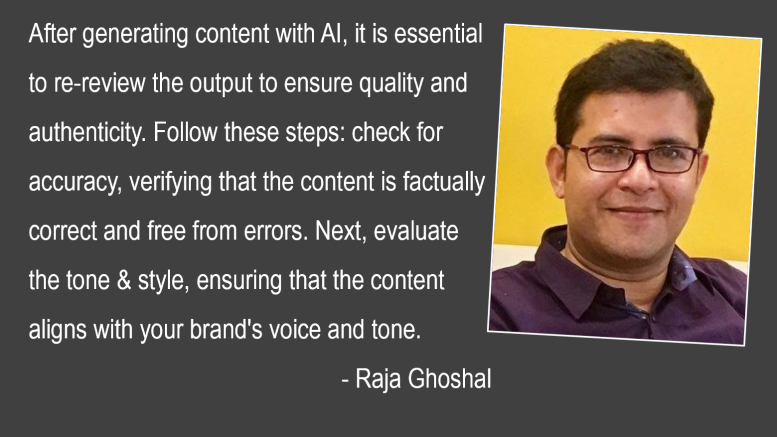In today’s fast-paced digital landscape, corporate communication professionals the world over are increasingly turning to artificial intelligence (AI) to streamline content creation and enhance productivity. Generative AI tools, such as ChatGPT, Copilot and JasperAI and many others offer powerful capabilities for drafting, editing, and brainstorming content.
However, leveraging these tools effectively requires a strategic approach to ensure authenticity, creativity, and quality. This article explores best practices for using AI in content creation, highlighting what to do and more importantly what not to do, and the golden rule of providing detailed prompts to maintain genuineness.
What to Do: Best Practices for Using AI in Content Creation
Define the Purpose of the Content: Before generating content, clearly define the purpose, target audience, and desired tone. This helps guide the AI tool and ensures that the content aligns with your brand’s goals.
Craft Detailed and Specific Prompts: Provide explicit instructions and constraints to the AI model. A well-structured prompt should include the topic, key points, desired length, and any specific requirements. For example, “Write a 500-word blog post on the benefits of remote work, highlighting increased productivity and work-life balance.”
Use AI for Initial Drafts: Utilise AI to generate first drafts of content, saving time and overcoming writer’s block. This approach allows you to focus on refining and personalising the content later.
Edit and Refine AI-Generated Content: Review the AI-generated content carefully, making necessary edits on your own to ensure accuracy, coherence, and alignment with your brand’s voice. Pay attention to grammar, tone, and style, including personal style to maintain professionalism.
Incorporate Human Touch: Blend AI efficiency with human insight. Add personal anecdotes, unique perspectives, and emotional appeal to make the content relatable and engaging.
Maintain Transparency: Clearly indicate when content is AI-generated. This builds trust with your audience and ensures transparency in your communication efforts.
What Not to Do: Common Pitfalls to Avoid
Over-Reliance on AI: Avoid relying solely on AI for content creation. While AI can enhance productivity, human creativity and expertise are essential for producing high-quality, authentic content.
Ignoring Ethical Considerations: Be mindful of ethical issues such as plagiarism, bias, and misinformation. Ensure that AI-generated content adheres to ethical guidelines and respects copyright laws.
Neglecting Review and Verification: Do not skip the review process. Thoroughly check AI-generated content for accuracy, relevance, and consistency with your brand’s messaging.
Lack of Personalisation: Avoid producing generic, one-size-fits-all content. Tailor the content to your audience’s needs and preferences to create a meaningful connection. Maintain authenticity and creativity with detailed and unique prompts. Go the extra mile in giving nuanced prompts.
Re-Reviewing AI Output
After generating content with AI, it is essential to re-review the output to ensure quality and authenticity. Follow these steps: check for accuracy, verifying that the content is factually correct and free from errors. Next, evaluate the tone & style, ensuring that the content aligns with your brand’s voice and tone. Finally, never forget to add your personal touch – incorporate personal insights, anecdotes, and unique perspectives and your trademark style to make the content more relatable.
Last but not the least, seek real time feedback by sharing the content with colleagues or stakeholders for suggestions. Make any necessary revisions based on feedback before finalisation.
Conclusion
Leveraging AI for generative content offers numerous benefits for corporate communication professionals, including increased efficiency, enhanced creativity, and streamlined workflows. By following best practices, maintaining authenticity, and re-reviewing AI output, professionals can harness the power of AI while ensuring high-quality, genuine content. At the end of the day, embracing AI as a strategic partner and a valuable assistant in content creation can lead to more impactful and engaging communication efforts. But, remember you are still the boss, responsible and accountable for the content that goes from your end!
The views and opinions published here belong to the author and do not necessarily reflect the views and opinions of the publisher.



Be the first to comment on "Leveraging AI for Generative Content: Best Practices for Corporate Communication Professionals"